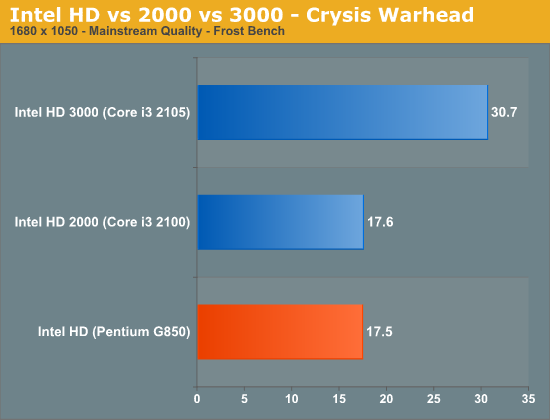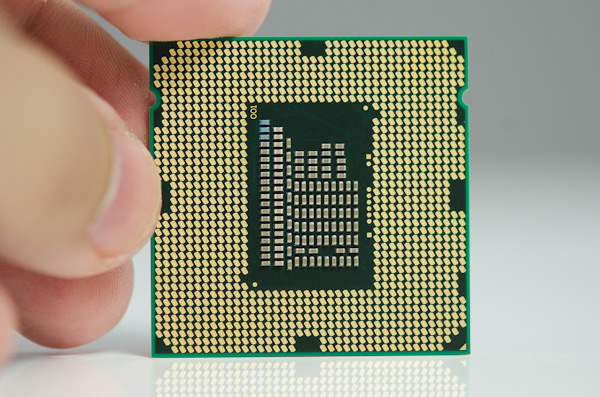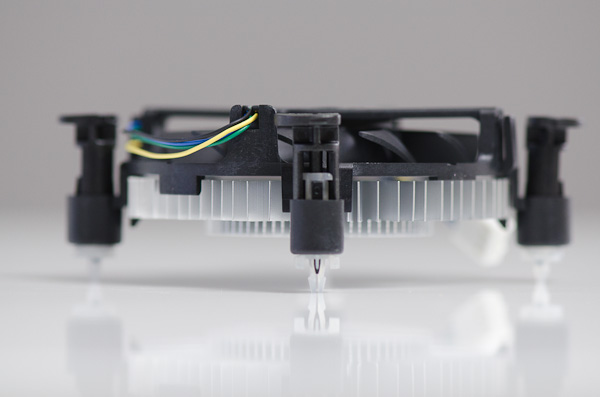The Sandy Bridge Pentium Review: G850, G840, G620 & G620T Tested
by Anand Lal Shimpi on August 23, 2011 12:11 AM ESTIn 2006 Intel introduced its tick-tock cadence for microprocessor releases. Every year would see the release of a new family of microprocessors as either a tick or a tock. Ticks would keep architectures relatively unchanged and focus on transitions to smaller manufacturing technologies, while tocks would keep fab process the same and revamp architecture. Sandy Bridge was the most recent tock, and arguably the biggest one since Intel started down this road.
At a high level the Sandy Bridge CPU architecture looked unchanged from prior iterations. Intel still put forth a 4-issue machine with a similar number of execution resources to prior designs. Looking a bit closer revealed that Intel completely redesigned the out-of-order execution engine in Sandy Bridge, while heavily modifying its front end. Sandy Bridge also introduced Intel's high performance ring bus, allowing access to L3 by all of the cores as well as Intel's new on-die GPU.
The Sandy Bridge GPU was particularly surprising. While it pales in comparison to the performance of the GPU in AMD's Llano, it does represent the first substantial effort by Intel in the GPU space. Alongside the integrated GPU was Intel's first hardware video transcoding engine: Quick Sync. In our initial review we found that Quick Sync was the best way to quickly transcode videos, beating out both AMD and NVIDIA GPU based implementations in our tests. Quick Sync adoption has been limited at best, which is unfortunate given how well the feature performed in our tests.
Sandy Bridge wasn't all rosy however. It was the first architecture that Intel shipped with overclocking disabled on certain parts. Any CPU without Turbo Boost enabled is effectively unoverclockable. Intel killed the low end overclocking market with Sandy Bridge.
The overclocking limits were a shame as Sandy Bridge spanned a wide range of price points. The low end Core i3-2100 was listed at $117 while the highest end Core i7-2600K came in at $317. While you can't claim that Sandy Bridge was overpriced at the high end, there's always room for improvement.
Despite abandoning Pentium as a high end brand with the 2006 release of Intel's Core 2 Duo, Intel has kept the label around for use on its value mainstream parts. Last year we saw only two Pentium branded Clarkdale parts: the G6950 and G6960. This year, powered by Sandy Bridge, the Pentium brand is a bit more active.
| Processor | Core Clock | Cores / Threads | L3 Cache | Max Turbo | Max Overclock Multiplier | TDP | Price |
| Intel Core i7 2600K | 3.4GHz | 4 / 8 | 8MB | 3.8GHz | 57x | 95W | $317 |
| Intel Core i7 2600 | 3.4GHz | 4 / 8 | 8MB | 3.8GHz | 42x | 95W | $294 |
| Intel Core i5 2500K | 3.3GHz | 4 / 4 | 6MB | 3.7GHz | 57x | 95W | $216 |
| Intel Core i5 2500 | 3.3GHz | 4 / 4 | 6MB | 3.7GHz | 41x | 95W | $205 |
| Intel Core i5 2400 | 3.1GHz | 4 / 4 | 6MB | 3.4GHz | 38x | 95W | $184 |
| Intel Core i5 2300 | 2.8GHz | 4 / 4 | 6MB | 3.1GHz | 34x | 95W | $177 |
| Intel Core i3 2120 | 3.3GHz | 2 / 4 | 3MB | N/A | N/A | 65W | $138 |
| Intel Core i3 2100 | 2.93GHz | 2 / 4 | 3MB | N/A | N/A | 65W | $117 |
| Intel Pentium G850 | 2.9GHz | 2 / 2 | 3MB | N/A | N/A | 65W | $86 |
| Intel Pentium G840 | 2.8GHz | 2 / 2 | 3MB | N/A | N/A | 65W | $75 |
| Intel Pentium G620 | 2.6GHz | 2 / 2 | 3MB | N/A | N/A | 65W | $64 |
| Intel Pentium G620T | 2.2GHz | 2 / 2 | 3MB | N/A | N/A | 35W | $70 |
The new Sandy Bridge based Pentiums fall into two lines at present: the G800 and G600. All SNB Pentiums have two cores (HT disabled) with 256KB L2 per core and a 3MB L3 cache. CPU core turbo is disabled across the entire Pentium line. From a performance standpoint, other than missing hyper threading and lower clocks - the Sandy Bridge Pentiums are very similar to Intel's Core i3.
Intel continues to separate the low end from the high end by limiting supported instructions. None of the Pentiums support AES-NI or VT-d. Other than higher clock speeds the 800 series only adds official DDR3-1333 support. The 600 series only officially supports up to DDR3-1066.
All standard Pentiums carry a 65W TDP. The Pentium G620T runs at a meager 2.2GHz and manages a 35W TDP. Regardless of thermal rating, the boxed SNB Pentiums come with an ultra low profile cooler:
These Pentium CPUs work in the same 6-series LGA-1155 motherboards as their Core i3/5/7 counterparts. The same rules apply here as well. If you want video out from the on-die GPU you need either an H-series or a Z-series chipset.
The Pentium GPU
When Intel moved its integrated graphics on-package with Clarkdale it dropped the GMA moniker and started calling it HD Graphics. When it introduced the Sandy Bridge Core i3/5/7, Intel added the 2000 and 3000 suffixes to the HD Graphics brand. With the Sandy Bridge Pentium, Intel has gone back to calling its on-die GPU "HD Graphics".
Despite the name, the Pentium's HD Graphics has nothing in common with Clarkdale's GPU. The GPU is still on-die and it features the same architecture as Intel's HD Graphics 2000 (6 EUs). Performance should be pretty similar as it even shares the same clock speeds as the HD 2000 (850MHz base, 1.1GHz turbo for most models). I ran a quick test to confirm that what Intel is selling as HD Graphics is really no different than the HD Graphics 2000 in 3D performance:

All is well in the world.
Where the vanilla HD Graphics loses is in video features: Quick Sync, InTru 3D (Blu-ray 3D), Intel Insider (DRM support for web streaming of high bitrate HD video) and Clear Video HD (GPU accelerated post processing) are all gone. Thankfully you do still get hardware H.264 video acceleration and fully audio bitstreaming support (including TrueHD/DTS-HD MA).
Missing Quick Sync is a major blow, although as I mentioned earlier I'm very disappointed in the poor support for the feature outside of the initial launch applications. The rest of the features vary in importance. To someone building a basic HTPC, a Sandy Bridge Pentium will do just fine. Personally I never play anything in 3D, never use the Clear Video HD features and never use Intel Insider so I wouldn't notice the difference between a Sandy Bridge Pentium and a Core i5 for video playback.



















110 Comments
View All Comments
loeakaodas - Tuesday, August 23, 2011 - link
Why intel, why? Do you still ram these chips down our throats, they're so short of features that would be great for a cheap HTPC, but aren't all that attractive if you want to do anything but basic stuff with your machine.Blaze-Senpai - Tuesday, August 23, 2011 - link
And this is aimed at those people that only want to do basic stuff with their machine.yankeeDDL - Tuesday, August 23, 2011 - link
It still makes no sense: a Pentium 850 costs $98 (http://www.newegg.com/Product/Product.aspx?Item=N8... an A6-3650 costs $119 (http://www.newegg.com/Product/Product.aspx?Item=N8...For $20 you get a real graphic cards which acelerated web browsing and video decoding, so it is actually very useful even for very basic systems.
I see no value, whatsoever, for entry-level Sandy Bridge, as they have a higher price/performance ratio than most AMD stuff.
Incidentally, while SB is undoubtedly the finest piece of CPU technology today, at these prices it makes sense only starting from the Core i5-2400, which, basically, outperforms nearly every AMD CPU.
ET - Tuesday, August 23, 2011 - link
A G620 plus a discrete low mid range ($70-80) GPU will give you a much better entry level gaming PC than an A6-3650, for not a lot more money. (For about the same price as an A8-3850, which will still be slower for gaming than the G620 system).yankeeDDL - Tuesday, August 23, 2011 - link
I am not convinced, but you might be right about the gaming rigs. I would argue that a cheap discrete graphic card would CrossFire nicely with tha A6, but that's not the point anyway.I was talking, however, about entry-level systems.
There`s a "Best CPU for the money" update on Tom's hardware today: you can see that the G620 is not even in the picture, in favor of the Athlon II X3 and the G850.
If I was to play games rarely, I would much rather have an efficient but relatively powerful APU, than having to use an external graphic card: this way I wouldn't have to pay the electricity bill to have my GPU run a screensaver.
Taft12 - Tuesday, August 23, 2011 - link
Perhaps, but an Athlon II X3 450 plus the same $70-80 GPU would make for an even better entry level gaming PC at the same price.lowlymarine - Tuesday, August 23, 2011 - link
Not really. Many games still struggle to hit even two cores efficiently; few if any would benefit significantly from the third.Roland00Address - Tuesday, August 23, 2011 - link
For example see Grand Theft Auto IV PC edition. This game is unplayable on a Dual Core pc without a massive overclock, but runs fine on a slow tri or quad core. This was due to Xbox 360 having a tri-core processor (The 360 cpu is also a PowerPC design not x86 but that doesn't really matter.)Samus - Tuesday, August 23, 2011 - link
great article Anand!owned66 - Sunday, February 10, 2013 - link
most games after 2011play very well with multicore systems
my qx6700 was maxed out at 100% playing bf3
playing with a 2600 sandy maxes out at 85% equally on all cores and gpu maxed at 100% gpu load
increasing gpu clocks would increase cpu load which is a good sign of fine tuning